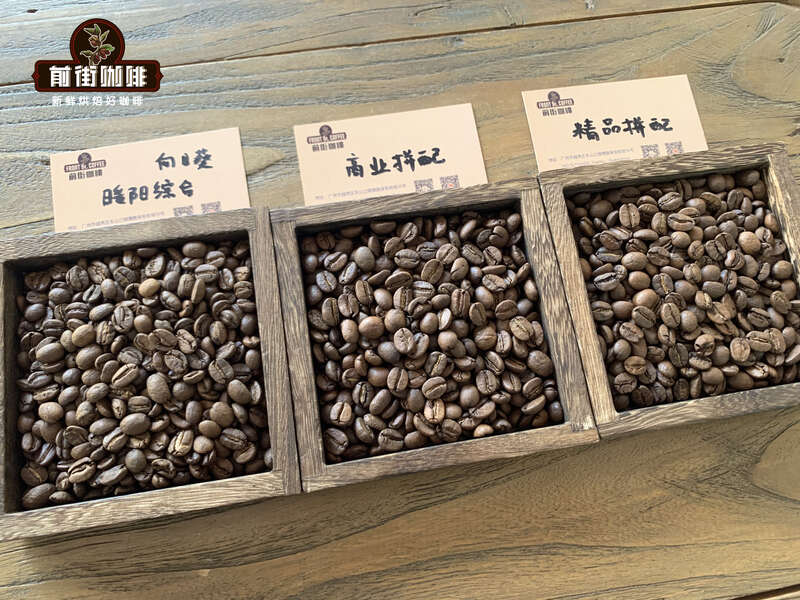The difference between coffee beans and espresso beans the deeper the espresso beans are roasted, the better?
In the coffee we drink, are the coffee beans the same? is there still any difference? the hand-brewed coffee we drink is fine coffee beans, and so is the espresso? Yes, there is a difference between coffee beans and espresso beans! They're not the same thing! To make espresso, you can use any coffee beans you like. After all, espresso is just another brewing method. But is it really? Compared with other brewing methods, the water temperature is lower and the contact time is very short. This is because the brewing process is carried out under pressure (at least 9 bar). That's what makes espresso unique.
Because of this, most espresso beans tend to have deeper baking curves because they are easier to extract than shallow roasting under these conditions. Espresso beans need to pay special attention to the selection of coffee for blending and the selection of baking curves. In order to ensure the best extraction and maximize the taste, the roaster developed an espresso mixture.
The mixing of coffee beans is good for espresso.
First of all, what makes coffee beans suitable for making espresso is to choose coffee to develop mixed coffee. Not all coffees are the same, and certain criteria must be taken into account when looking for the most suitable coffee to extract espresso. Bitterness, sweetness and taste all play a role.
A middle ground can be found in the espresso flavor spectrum. Whether you like fruity and rich taste, or bitter and mild taste, the perception of taste has a lot to do with the interaction between bitterness and sweetness in the cup. Coffee must be adapted to deeper roasting. The bitter taste is good to some extent and can be used as a base for slicing milk in cappuccino coffee.
There should also be different degrees of sweetness from one coffee to another. However, flavor is only part of the pleasure of espresso. The other part is its tactile attraction. The viscosity of espresso itself must be pleasant in taste.

The best roasting of espresso
For all types of coffee beans, the roasting process is alpha and omega. This is where differences in tasting, flavor and brewing methods play a role.
The general rule is that light roasting works best using slower extraction methods (such as filtering coffee). Instead, deeper roasting uses quick methods, such as espresso.
In addition to being easier to extract, developing deeper baking can strengthen the body and eliminate acidic foods.
The baker must choose the right baking method: shallow baking does not match well with milk (cappuccino), and too deep baking can cause problems and bitterness in the cup.
What's the difference between espresso beans and coffee beans?
Coffee beans
Coffee beans are any coffee beans that have been roasted and prepared to be brewed. There are boutique coffee beans and individual coffee beans. If you want the completely unique flavor of beans, you can choose to bake lightly, depending on which country the beans come from.
Light roasted coffee beans have no greasy luster and are best suited for mild varieties, white coffee and non-pressure brewing styles, such as hand-brewed coffee or cold brewed coffee.
Moderately baked beans can be distinguished by their medium brown. They provide you with more intense brewing, produce different flavor characteristics, and are based on legume sources and can be used in a variety of brewing methods. On the other hand, deep-roasted beans stand out because of their dark brown and shiny oily surface. In most cases, medium and deep roasting is used for espresso brewing.
Espresso beans
Espresso beans usually fall into the deep-roasted category because at this stage, coffee beans have the lowest acidity but are fuller. You can still get hints about the taste of beans. The dark roasting of espresso beans contains the most abundant coffee natural oil, which can be clearly seen in the oily luster of coffee beans. These oils are emulsified with other compounds in coffee and have been shown to help produce coffee fat.
However, care must be taken not to use beans that are too deep-roasted, as excess oil can clog grinders, especially in super automatic machines.
Making espresso from regular coffee beans may not produce the desired "perfect brewing", no matter how good they are.
Some varieties are too light, others may be too charred or too black.
This is a quick overview of why the right beans must be used to make high-quality espresso.
Espresso beans provide the required consistency, richness and flavor. They usually produce a full-bodied Krima, which enhances the entire beverage and espresso experience. Ordinary coffee beans are suitable for various brewing methods, but espresso beans are the most suitable for high pressure methods.
Important Notice :
前街咖啡 FrontStreet Coffee has moved to new addredd:
FrontStreet Coffee Address: 315,Donghua East Road,GuangZhou
Tel:020 38364473
- Prev

What is the color of Crema Crisma Coffee Coffee has anything to do with extraction
Espresso Cleima, compared with espresso, Crema is often mentioned. It refers to the light color layer formed on the surface of brewed coffee during the extraction stage. When brewing espresso, carbon dioxide from compacted fresh coffee grounds meets hot, pressurized water, resulting in trademark bubbles. Klima tells a lot about the coffee we're going to drink, and we have
- Next

How to choose coffee beans with low acidity? which coffee beans have lower acidity?
Without acidity, the taste of coffee will become dull and tasteless. Acidity is an ideal major coffee flavor sensation, which is considered to be the pleasant sharpness of the front of the mouth, the numbness of the tip of the tongue or the dryness of the back of the upper jaw and / or below the edge of the tongue; indicates the quality of the coffee. Good acidity tends to be sweet, crisp and sour to enhance other qualities of coffee. Coffee famous for its pleasant acidity
Related
- What brand of black coffee is the most authentic and delicious? what are the characteristics of the flavor of the authentic Rose Summer Black Coffee?
- Introduction to the principle and characteristics of the correct use of mocha pot A detailed course of mocha pot brewing coffee is described in five steps.
- Which is better, decaf or regular coffee? how is decaf made?
- How much is a bag of four cat coffee?
- How about four Cat Coffee or Nestle Coffee? why is it a cheap scam?
- Which is better, Yunnan four Cats Coffee or Nestle Coffee? How about cat coffee? is it a fake scam? why is it so cheap?
- How about Cat Coffee? what grade is a hoax? which instant coffee tastes better, four Cat Coffee, Nestle Coffee or G7 coffee?
- Process flow chart of coffee making-Starbucks coffee making process what coffee tastes good at Starbucks
- The top ten best coffee beans in the world Rose summer coffee or Tanzanian coffee tastes good
- Yunnan four cat coffee is good to drink?_four cat coffee is a big brand? four cat blue mountain coffee is fake?

